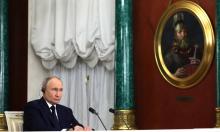Growing Euro Increases Russian Foreign Debt
Russia has made considerable payments to serve the debt, but the euro has brought those efforts to nothing
The US dollar continued growing at the morning tender in Sydney. The dollar/euro rate has already reached the level of 1,668. Specialists say that market dealers hope that the European Central Bank will reduce the basic interest rate again. The administration of the European Central Bank has recently corrected its quiet attitude towards the growth of the European currency. Last week (after the rate was cut by 50 points), ECB President Wim Duisenberg did not deny a possibility of the future reduction of the rate. The ECB head added that there were certain opportunities left, that the rate in the euro zone was still higher than in the USA.
National Australia Bank specialists believe that the dollar started showing a strong influence on the economic growth of Asia and Europe after the six-month long demise. It may eventually stop the dollar reduction. Nevertheless, specialists of the bank do not exclude euro's further growth either. The euro went up to the level of $1,171 at the Asian trading session – this is the level, to which the euro dropped last Friday, after the May issue of the employment report had been published in the USA. However, specialists can not determine the reasons, which have resulted in the retrieval of the euro rate after its reduction on Tuesday. Market members believe that someone ordered to buy a lot of European currency – rumors about Arabian investors and governments buying up the euro have become rather frequent recently. Dow Jones Newswires reported that the Saudi Arabia Monetary Agency (SAMA) had acquired 30 billion euro over recent six or eight weeks. It goes without saying that it could not but affect the level of currency quotations.
In Russia, the US dollar has gained 12 kopecks after three days of reduction. The weighted average dollar rate made up 30,58 rubles per one dollar. Specialists think that the Russian Central Bank has interfered in the situation, since the ruble gained 30 kopecks against the dollar within a short period of time. Most likely, the Russian Central Bank decided to restrain the sliding American currency. The Bank did not have to take much efforts about it, because the volume traded at special session "tomorrow" made up a bit more than $78, which testified to excessive dollar supplies on the market.
The demising dollar and the strengthening euro are still a source of trouble both for the Central Bank and for the Finance Ministry of Russia. Officials of the finance ministry have recently announced that the peak of the Russian foreign debt payment had been left behind for this year. Yet, the Russian foreign debt does not diminish in spite of the progress. Ministerial officials think that the growing euro rate increases the dollar-calculated foreign debt, in spite of considerable payments that have been done to serve the debt recently. The amount of the Russian foreign debt made up $124,8 billion as of April 1, 2003. However, the debt was evaluated in the sum of $123.5 billion in the beginning of the current year. The Russian Finance Ministry has not raised any loans during that period and paid more than $4,5 billion. On the whole, Russia has paid about $9,5 billion to foreign creditors since the beginning of the year.
The euro rate has gained more than four percent against the dollar over the first quarter of 2003. A part of the Russian foreign debt (to the IMF and the Paris Club, first and foremost) that is calculated in the European currency – 70 percent of the entire debt – has increased as well. The addition has brought finance ministry's efforts to nothing. The volume of the debt might grow even more by July 1st, when Russia is to make another payment to foreign creditors. Despite considerable payments in the second quarter in comparison with the first one ($5,5 billion), the euro was growing faster than in the beginning of the year, having gained seven percent.
Subscribe to Pravda.Ru Telegram channel, Facebook, RSS!





